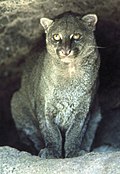- The following is an archived discussion of the DYK nomination of the article below. Please do not modify this page. Subsequent comments should be made on the appropriate discussion page (such as this nomination's talk page, the article's talk page or Wikipedia talk:Did you know), unless there is consensus to re-open the discussion at this page. No further edits should be made to this page.
The result was: promoted by Yoninah (talk) 10:18, 27 May 2020 (UTC)
Jaguarundi

Jaguarundi
Improved to Good Article status by Sainsf (talk). Self-nominated at 17:45, 22 April 2020 (UTC).
It doesn't look anything like an otter or a weasel! Gatoclass (talk) 10:09, 23 April 2020 (UTC)
- It doesn't look exactly like them, but has many of their features for sure as the given and many other sources note (especially if you compare this cat and the tayra). Maybe the pictures on Commons can't show this well as they don't show a clear, full body view. This is an interesting fact because this cat looks less like most others in its own family but resembles this other family. Sainsf (talk · contribs) 10:44, 23 April 2020 (UTC)
- I haven't looked at the sources yet, but the article nowhere states that this species "superficially resembles mustelids" - all it says is that it has some features in common with them, which is a completely different statement. At the very least, you need to include the hook statement in the article. Update: now I have looked at the sources, and one of them says the cat "is sometimes said to resemble a weasel or otter in external appearance". The resemblance is lost on me, but apparently somebody thinks otherwise. But based on that source, the hook statement is nonetheless an overstatement. I think the hook will work if you add "is said to superficially resemble" or something like that. But you still need to have the same statement in the article. Gatoclass (talk) 11:09, 23 April 2020 (UTC)
- I see. The wording was a bit too strong and I should have backed it up with more sources cited inline. I stick to 'similar features' as that is what most sources say, the 'superficial' claim is not that common. I think it should be better now. Sainsf (talk · contribs) 16:35, 23 April 2020 (UTC)
 ALT1 is good to go, in my opinion. Psiĥedelisto (talk) 08:26, 15 May 2020 (UTC)
ALT1 is good to go, in my opinion. Psiĥedelisto (talk) 08:26, 15 May 2020 (UTC)
 Full review needed, since it never has been done; superseding highly premature tick. BlueMoonset (talk) 04:17, 19 May 2020 (UTC)
Full review needed, since it never has been done; superseding highly premature tick. BlueMoonset (talk) 04:17, 19 May 2020 (UTC)
| General: Article is new enough and long enough
|
|
|
| Policy: Article is sourced, neutral, and free of copyright problems
|
|
|
| Hook: Hook has been verified by provided inline citation
|
|
|
| Image: Image is freely licensed, used in the article, and clear at 100px.
|
|
|
Overall:  Good article. Open to other hooks. --evrik (talk) 00:08, 25 May 2020 (UTC)
Good article. Open to other hooks. --evrik (talk) 00:08, 25 May 2020 (UTC)
 Hi, I came by to promote this. We don't put words in parentheses in hooks. Do you have a source that verifies otters and weasels? Otherwise we'll end the hook at "mustelids". Thanks, Yoninah (talk) 23:48, 26 May 2020 (UTC)
Hi, I came by to promote this. We don't put words in parentheses in hooks. Do you have a source that verifies otters and weasels? Otherwise we'll end the hook at "mustelids". Thanks, Yoninah (talk) 23:48, 26 May 2020 (UTC)
- @Yoninah: Maybe we can change it to a comma, but the examples would be very helpful as "mustelid" is not a common term. All the 4 sources after the relevant sentence in the article mention otters and/or weasels, two of them are [1] and [2]. Sainsf (t · c) 06:32, 27 May 2020 (UTC)
 Thank you. Restoring tick. Yoninah (talk) 10:16, 27 May 2020 (UTC)
Thank you. Restoring tick. Yoninah (talk) 10:16, 27 May 2020 (UTC)
 ALT1 is good to go, in my opinion. Psiĥedelisto (talk) 08:26, 15 May 2020 (UTC)
ALT1 is good to go, in my opinion. Psiĥedelisto (talk) 08:26, 15 May 2020 (UTC) Full review needed, since it never has been done; superseding highly premature tick. BlueMoonset (talk) 04:17, 19 May 2020 (UTC)
Full review needed, since it never has been done; superseding highly premature tick. BlueMoonset (talk) 04:17, 19 May 2020 (UTC)![]() Good article. Open to other hooks. --evrik (talk) 00:08, 25 May 2020 (UTC)
Good article. Open to other hooks. --evrik (talk) 00:08, 25 May 2020 (UTC)
 Hi, I came by to promote this. We don't put words in parentheses in hooks. Do you have a source that verifies otters and weasels? Otherwise we'll end the hook at "mustelids". Thanks, Yoninah (talk) 23:48, 26 May 2020 (UTC)
Hi, I came by to promote this. We don't put words in parentheses in hooks. Do you have a source that verifies otters and weasels? Otherwise we'll end the hook at "mustelids". Thanks, Yoninah (talk) 23:48, 26 May 2020 (UTC)